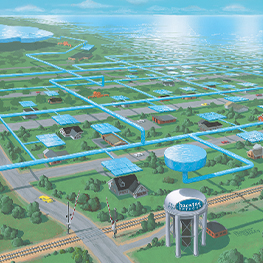Water Distribution

Immerse yourself in industry-leading tools like WaterGEMS, which is cutting-edge hydraulic modeling and simulation software. You can integrate Geographic Information System (GIS) data with Quantum GIS (QGIS) or ArcGIS for comprehensive spatial analysis, adding a powerful layer to your water network design capabilities. This training offers a unique opportunity for hands-on, practical learning enabled
by participation in exercises, practical scenarios, and a real-world project to ensure that you not only understand theoretical concepts but also develop the practical skills required to excel at water network design. Our experienced professionals in water engineering, GIS integration, and hydraulic modeling will take you through the tools and methodologies, providing valuable insights and real-world examples. The curriculum is carefully designed to cover a wide range of topics required for water distribution network design. You will learn everything you need to know about comprehensive water network planning, including data collection, GIS-based spatial analysis, pipe sizing, pump selection, water pressure management, and system optimization. Master the integration of QGIS with WaterGEMS in depth,
learning about its role in water distribution network design and the practical use of GIS data for enhanced spatial analysis. Learn about water quality analysis, and scenario management to ensure that network designs are robust, efficient, and sustainable.
INSTRUCTORS:

HAKIZIMANA Theogene
ASSISTANT TRAINER

Gashuri Yves Lionel
ASSISTANT TRAINER
As a participant, you will be able to review real-world case studies that provide practical insights into successful water distribution network design projects. The course also includes a final project in which you will design a comprehensive water distribution network using the knowledge and skills you learned throughout the training. Join us as we master the tools and techniques that will shape the future of water networks.
BENEFITS OF JOINING THIS TRAINING:
This comprehensive program is designed to equip you with the expertise needed to excel in water distribution systems design. Throughout this course, you will:
Gain in-depth knowledge of water distribution systems, including components and basic
hydraulic principles, laying a solid foundation for water network design.
Acquire practical skills in using WaterGEMS software, from installation to creating a network
model, pipe sizing, pump selection, and system optimization.
Understand the role of QGIS in water distribution design and learn how to seamlessly integrate
GIS data into WaterGEMS for comprehensive spatial analysis.
Utilize QGIS for spatial analysis in water distribution planning and visualize and analyze water
demand patterns, incorporating land use and population data.
Implement pressure control measures using WaterGEMS, ensuring compliance with pressure
requirements across different parts of the network.
Explore the use of QGIS for water quality analysis, spatial mapping of water quality parameters,
and integration with the overall network model.
Learn to optimize water distribution network designs for efficiency and cost-effectiveness using
WaterGEMS, exploring various design scenarios and managing them effectively.
Identify common operational challenges in water distribution networks and learn how to
troubleshoot and address them effectively.
Receive a certification from Bentley systems upon successful completion of the course,
showcasing your proficiency in water distribution network design with WaterGEMS and QGIS.
WHO SHOULD ATTEND THIS TRAINING?
This training program is specifically tailored for individuals who occupy various roles within the water engineering industry and seek to advance their proficiency in hydraulic modeling and system optimization. Here are the primary target audiences:
Water Engineers: Professionals involved in water engineering, responsible for designing and managing water distribution networks.
Civil Engineers: Individuals working in civil engineering, particularly those focused on water infrastructure and distribution systems.
Hydraulic Engineers: Engineers specializing in hydraulic systems and fluid mechanics, seeking expertise in water distribution network design.
Water System Planners: Planners involved in the strategic planning of water distribution systems, optimizing network design for efficiency and sustainability.
Municipal Engineers: Engineers working for municipalities responsible for the design and
management of water distribution infrastructure.
Water Utility Professionals: Individuals working for water utility companies involved in the design, optimization, and management of water distribution networks.
Government Officials and Regulators: Officials and regulators responsible for overseeing water distribution infrastructure and ensuring compliance with standards.
This course provides a valuable opportunity for professionals to elevate their expertise in water distribution through advanced training in hydraulic modeling and system optimization. Join us to unlock new insights and strategies for building resilient and efficient water networks.
